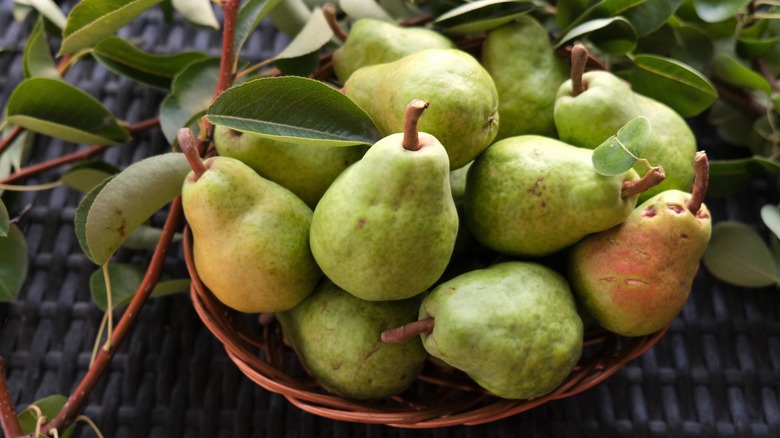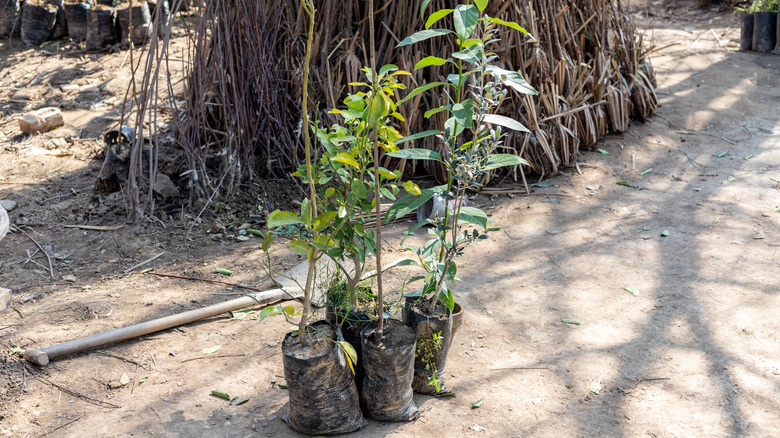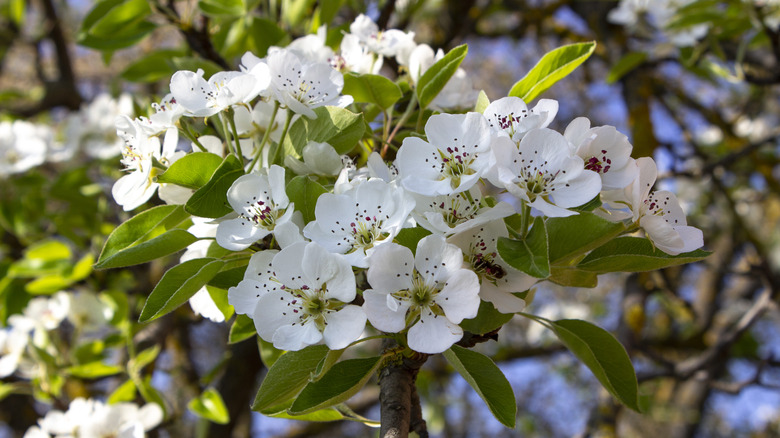Juicy Tips For Growing Bartlett Pear Trees With Delicious Fruits
Bartlett pears — aka the most popular pears in the world — are large, soft, sweet, juicy green or yellow fruits that taste just as delicious eaten raw as they do when baked or flambéed in decadent dessert recipes. As with all fruits, however, the quality of the pear begins long before it ever emerges. Proper placement, pollination, irrigation, and general care of the fruit tree are essential for the production of high-quality Bartlett pears.
If you've been dreaming of a pair-inclusive orchard, there are a few tips to consider when planning and planting a fruit orchard in your yard. Or, if you prefer only a personal supply of Bartlett pears, it is key to familiarize yourself with these pear trees' somewhat specialized care requirements before investing your time and money. Consider this your guide to all the juicy tips you need to start harvesting more delicious pears than you can handle, including cold weather, lots of sunlight, acidic soil, and lots of time. It takes new Bartlett pear tree three to 10 years to mature enough to bear fruit. Of course, if you're a bit impatient, you may also consider transplanting a tree that has already reached maturity. Just be sure to transplant it in early spring, before it has started to produce buds.
Beginning the juicy journey: how to plant a Bartlett pear tree
Before you plant your Bartlett pear tree(s), ensure you are in hardiness zones 5-7. These trees require cold weather to produce their delightful fruits (500-800 chill hours — to be exact). Then, you'll need to select a proper location. These trees prefer full sun and will produce more pears of higher quality when they receive more direct sunlight. Your trees will also need well-draining soil that will require some specific preparation before planting. Bartlett pear trees grow and produce best in slightly acidic soil with a pH of 5.9-6.5. If you know your soil isn't this acidic, you'll want to acquire and apply an acidifying product with ingredients like sulfur. If you're unsure of your soil's pH level, make a DIY soil test and conduct it before proceeding.
First, each tree will need a hole about twice the width of its root ball and just deep enough to bury it slightly. The dirt that was removed from each hole should be mixed with organic matter like compost or aged manure to improve drainage and add nutrients. Remove any bag or wrapping and gently place the root ball and attached sapling into the hole. Then, fill the hole and cover the root ball with a very thin layer of the soil mixture, leaving its top level with the existing soil line. Water the root ball deeply to encourage settling.
Keeping the dream alive: caring for your Bartlett pear trees
For the best, juiciest Bartlett pears, specific methods need to be used when caring for your trees. First, watering needs to be deep and slow. Start by allowing the top few inches of soil to dry out before you water these trees. When you do water them, however, you'll want to utilize a drip line to provide a steady source of irrigation that thoroughly wets the roots. This will likely be necessary more than once per week between rains.
One of the best-kept secrets — when it comes to Bartlett pear trees — concerns the pollination process. While these trees are capable of self-pollination, the most productive trees are those that experience a pollination boost from other types of flowering pear trees planted in the area. If your Bartlett pear trees are full-sized varieties, this secondary type of pear tree of your choice should be planted within 100 feet. If your trees are dwarf varieties, they need to be within 20 feet. Keep your trees watered and allow them to receive plenty of cold. In a few years, fruit will begin to appear. In the meantime, prepare for a beautiful array of speckled white flowers each spring to hold you over.



